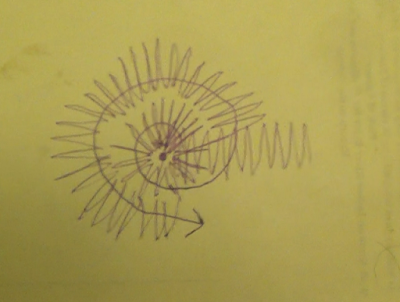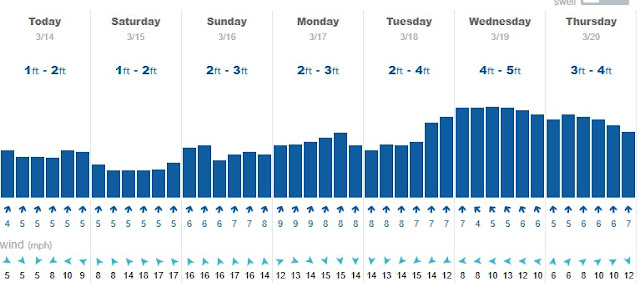 |
| Spiral Search Pattern Explained Below. |
I developed the spiral search pattern for metal detecting back in the 1980s when I was doing a lot of shallow water metal detecting, The spiral pattern has many benefits for working in the water - especially rough water with poor to no visibility.
When working in rough water, you might not be able to see the bottom at all. You might also have trouble staying over the target if the water is rough. When that is the case, the spiral search pattern is especially helpful.
When you get a metal detector signal and take your first scoop, you might not be able to see the hole and stay on the spot if the water is rough. After getting a good signal, quickly take a scoop, even if you do not expect to get the target. You can then use the use the hole to mark the location. Stick your scoop or foot in the hole to locate and try to stay on the spot. If a wave comes along and knocks you off the spot, you can find the spot again by feel. You can locate whatever remains of the hole with your foot or by feeling around with your long-handled scoop. Try to keep either your foot or scoop in touch with the spot, and of a wave pushes you off the spot, relocate the spot by feel as quickly as you can. Keep your toe over the hole or you scoop in the hole as much as you can to keep your position.
Of course, if you are using a scoop, you will have to pick it up to rescan the hole with your metal detector. You will have to do all of that as quickly as you can, and when the water is rough and you get knocked off the hole, you will have to relocate the hole by feel each time you are moved away by a wave.
There is always the possibility of multiple targets in a hole, and when you pick up your scoop with one or more targets, a target or two can fall out of the scoop and be moved by the current a short distance from the hole. It might take several attempts to retrieve the target and the currents might refill the hole.
After recovering or losing a target from the scoop, you can use your foot and or scoop to remain oriented relative to the hole and use that as the beginning point of your spiral, make your first circle around the hole to locate any remaining targets, including any that might have been lost and scattered. Of course you want to clean out the hole first. Keep the coil sweeps close together making sure to not leave anything in the hole, on the slope of the hole, or just outside the hole. Target can also get washed back into the hole and be reburied.
Being able to center your search on the hole by feel in rough conditions and poor visibility is one big advantage of the spiral pattern and the original reason I began using it. A long handle-scoop is an important tool under those conditions and the spiral pattern helps to locate additional targets around the hole or relocated targets that were lost during retrieval. In very rough conditions, targets can get washed out of the scoop and fairly farther away from the hole so move very slowly around the hole and then very gradually spiral out from the center of the hole as you take care to overlap sweeps.
In shallow water, it is not unusual for hot spots to form. It is also common for spills that get spread out with the currents. If during better visibility you ever watched a target slip out of your scoop and float to the bottom, you might have seen it drift in one direction or another. You might have seen how coins don't sink straight to the bottom but wobble back and forth as they settle through the water.
Putting it all together, the spiral pattern is great for shallow water detecting in rough water and poor visibility In conditions like that it is virtually impossible to detect in a straight line or in a tight grid. You can't see the ground that you intend to cover, therefore you need a way to reorient yourself relative to a known point and keep your pattern tight. Keeping your scoop in the center of the hole and running a spiral pattern allows you to keep a tight pattern under those conditions.
When the water is very rough and fairly deep (maybe chest to chin high) each wave can move you off your spot and far enough way that you lose contact with the hole. In an old post I once described how, instead of fighting the water like many people try to do by using weights, pick your feet up and go with the wave and let it take you and return you to the same spot, which you can refind with your toe or scoop. The trick is learning to pick your feet up at the right time and let wave take you and then return you. It is natural to try to fight or resist being moved by waves. It is easier when you learn to go with it. I've hunted when the waves kept smacking me in the head and knocking earphones off. It is easier to go with it. As Bruce Lee said, "Be like water."
I described the spiral pattern in my blog over a decade ago, but thought I would cover it more thoroughly today. For a previous post on the topic, see The Treasure Beaches Report Direct From Florida's Treasure Coast.: 5/24/13 Report - Another Key Plus Mystery Object, Linked Spirals Search Pattern for Water Hunting & Mound Builders.
I have also described the linked spiral search pattern befoe.
The linked spiral pattern is also useful in the shallow water or on a wet sand beach. It can be used to identify and follow target distribution patterns when you can clearly see the ground.
Here is the link where I described that. The Treasure Beaches Report Direct From Florida's Treasure Coast.: 3/3/16 Report - Linked Spiral Search Pattern For Rough Shallow Water Conditions.
The linked spiral pattern acknowledges that target distribution in the wet sand will not be random, but there will likely be clustering and distribution of targets by the density and type of target. There will possibly be coin lines or other non-random distribution patterns. I've previously done posts on coin lines and holes.
The thing I like about hunting wet sand areas is the increased likelihood of coins lines and easily discerned target distribution patterns. Target targets in an area of significant previous sand movement will be moved and distributed according to the water force and characteristics of the objects. I won't get into all that again now, but when conducting a spiral search, you might discover as you expand your pattern out from an original target hole that there are additional targets, and they may be distributed in a line in one direction or another.
 |
| Linked Spiral Search Pattern Showing Three Linked Spirals. |
The illustration above shows one possible situation. You are in the wet sand moving from right to left on the illustration. You hit a good target such as a coin. You then make a couple spirals around that hole but find no additional targets. After determining that there is a low probability of associated targets close to the dug target, you then continue moving along in the same direction as you were before.
The lack of additional targets found either to the right or left or above or below the first target you would decide to move on. How many spirals to make around the hole of a dug target before moving on involves some decision making. You might consider several factors, one of them being how tightly packed or dense you expect any coin line to be under the circumstances. If targets seem scarce and you have the time and patience you might make more spirals around each target. Your decision might also have to do with how dense you think any likely coin line might be. The type and value of the targets might also be factored in.
Anyhow, the illustration shows that after not finding anything more around the first hole, you moved on down the beach and hit a second good target then spiral around that hole and find another target to the north of the hole. So does that mean there will be more in that direction. We are not sure yet, but there is the chance, so we spiral around target three and eventually find that there are more targets above target three. Of course, you won't necessarily change the center of your spiral after the first new target. You can spiral around the original hole numerous times and read the signs of any possible pattern becoming evident.
In this example, we are using spirals around found targets to locate any nearby targets and proceeding in the direction of finds. The density of any existing target distribution patterns will determine to some extent how many times you have to spiral around a target to maximize your chances of finding nearby targets. Obviously if the targets are too far apart, and the distribution pattern is too loose, it will take more spirals to identify a pattern than if the pattern was tightly packed with multiple targets. If the target distribution pattern is too loose, it might not be of as much interest to you anyhow. You will have to use your judgement on how many spirals is enough.
===
 |
| Source: SurfGuru.com. |
As you can see, it looks like a higher surf will be coming next week.
There was a lunar eclipse last night, but it was turning cloudy, so I don't know how well it could be seen.
Good hunting,
TreasureGuide@comcast.net